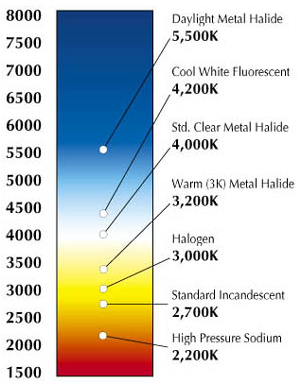When a black object such as a piece of iron is heated up it changes colour depending on the temperature that it is heated to. It turns out that this range of colors is very useful for describing the colour tint of white light.
You can actually determine the temperature of hot iron by measuring its color. When it reaches a temperature of 2,700º Kelvin (approx 2,426º Celsius), its glow will roughly match the colour of light emitted by your typical incandescent lightbulb (a yellowish colour). Because of the yellowish colour produced 2700K is generally referred to as "warm white".
As the colour temperature get higher the more blue the light becomes, so colour temperature kind of works in reverse in that a higher colour temperature actually indicates a more "cool" (blue) colour.
Typical values used:
2700K – 3000K = warm colours (yellowish white through red)
2800K "warm white"
4000K "natural white"
>5000K = cool colours (blueish white)
N.B. there is no agreed standard – warm white to one manufacturer is not necessaril;y warm white to another!
White LEDs
White LED's are created by taking a blue or ultraviolet LED and applying a phosphor to the lens to change the colour, in a similar way to how fluorescent lamps work. This allows the colour temperature to be selected, with warmer colours being less efficient as they requrie more phosphor to be applied. Due to the tiny size of the LED lenses, the tiny amount of phosphor applied and manufacturing processes you get variations in the actual colour temperature between batches of white LED's. To deal with this the factory will typically seperate the the LED's into bins according to colour temperature and or brightness. The more closely matched the LED's are the better the binning process. This binning is is one of the most important issues of white LED's when using them in applicaitons which requrie a matched colour temperature across batches.
The regulation of the binning process is outlined by the ANSI standards for tolerances of white color variations to fit within a color temperature group, or bin. Some LED manufacturers have adapted a more stringent process of sorting called micro-bins which allows for much smaller white color variations.


